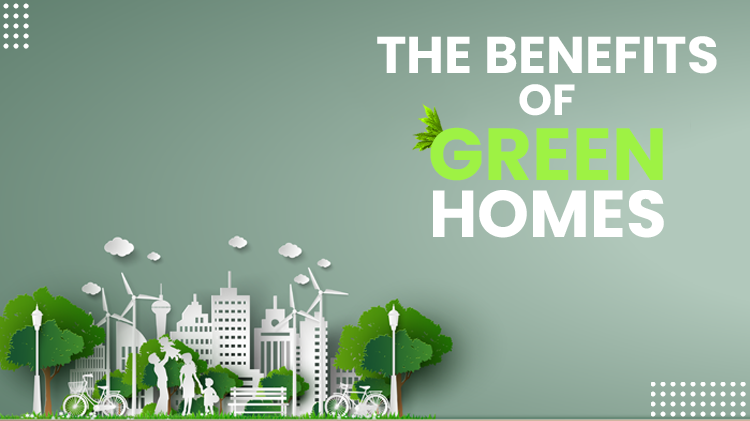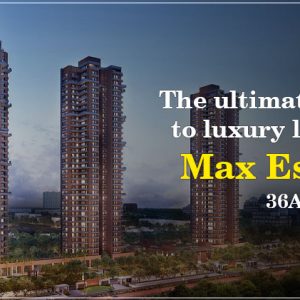Table of Contents
Investing in green homes offers a unique opportunity because it promotes sustainability while also being a prudent financial move. This essay thoroughly explores the several benefits of green homes, emphasizing their appeal to discerning homeowners who value both environmental responsibility and fiscal responsibility.
Green homes, usually referred to as eco-friendly or sustainable dwellings, have been increasingly popular in recent years, and for good reason. Beyond the admirable goal of reducing one’s environmental impact, green homes provide a number of practical advantages that appeal to both homeowners and investors.
Green homes can result in significant long-term financial savings. Due to eco-friendly features and materials, the initial expenditure may seem expensive, but the return on investment is strong. Improved insulation, solar panels, energy-efficient appliances, and smart home technology all reduce utility costs while raising the overall value of the house. Green homes are becoming more and more popular among cost-conscious homeowners looking to reduce their bills as energy costs continue to increase.
But the appeal of green homes goes far beyond financial rewards. Environmental sustainability is a core value held by a growing segment of homebuyers, who are driving demand for properties that reflect their values. Green homes incorporate sustainable building techniques that lessen carbon footprints, preserve water, and support a better indoor environment to meet this need. Prospective purchasers who wish to make a difference without sacrificing their lifestyle are drawn in large numbers by this harmonious union of environmental awareness and comfortable living.
The focus green homes place on having better indoor air quality is one of its distinguishing characteristics. Mold, poisons, and allergies can be found in traditional homes, which can lead to a variety of health problems. A healthier and more comfortable living environment is promoted by green homes, which place a high priority on effective ventilation systems, non-toxic building materials, and pollutant-reducing designs. The emphasis on holistic well-being is a strong selling point for green homes in the housing market since it appeals to people and families who are concerned about their health.
Additionally, green houses are more resilient to the unforeseen effects of climate change. They frequently incorporate passive heating and cooling systems, natural disaster-resistant materials, and rainwater collecting systems into their sustainable designs. Properties that provide safety and sustainability become more and more appealing to buyers looking for long-term security for their investment as climate-related worries grow.
In a larger sense, making green housing investments makes a big contribution to the worldwide fight against climate change. A sizable amount of energy demand and greenhouse gas emissions are caused by residential buildings. Homeowners can actively participate in the fight against environmental degradation by embracing green living areas. For those who see their housing decisions as a chance to be a part of a positive shift, this sense of responsibility and forward-thinking can be an appealing source of pride.
Understanding Green Homes
Energy Efficiency
Green homes are built with energy efficiency as a cornerstone, demonstrating a dedication to both prudent financial management and environmental responsibility. Modern technologies and creative designs are used in these homes to go beyond conventional ideas and reduce energy consumption.
Green homes are built with a systematic approach to energy reduction at their core. The integration of energy-efficient appliances and lighting systems makes this apparent. These elements greatly lower the household’s overall carbon footprint while simultaneously lowering utility costs. For instance, LED lighting boasts a longer lifespan while using a small fraction of the energy used by conventional incandescent bulbs. Such modest but significant decisions add up to significant energy savings over time.
Additionally, green homes emphasize insulation and ventilation systems as part of a comprehensive approach to energy efficiency. The development of insulating materials with remarkable thermal qualities as a result of construction innovations has ensured that indoor temperatures remain constant regardless of the weather outside. This improves comfort while also lessening the need for excessive heating or cooling, which further saves energy usage. These homes produce a balanced and energy-efficient climate when combined with clever ventilation systems, which encourage the circulation of fresh air while eliminating stale air.
Sustainable Materials
Another distinguishing feature of green homes is their use of sustainable materials, which shows careful consideration for the environment. Traditional building processes and materials frequently use a lot of resources, which leads to deforestation, pollution, and excessive carbon emissions. Green homes, on the other hand, advocate a different strategy by using eco-friendly substitutes that protect natural resources and minimize waste.
In these residences, recycled and repurposed materials are used extensively. Reusing materials like recycled glass or recovered wood not only keeps waste out of landfills but also gives the home’s design personality and distinction. Local material procurement also greatly lowers the carbon footprint caused by transportation. By choosing nearby supplies, homeowners can indirectly help the local economy while reducing the amount of energy used for transportation.
The usage of low-VOC (volatile organic compound) paints and adhesives is essential for sustainable materials. Traditional paints and adhesives frequently leak toxic compounds into the air, which causes indoor air pollution and a number of health problems. By utilizing low-VOC products that produce less hazardous emissions and promote better indoor air quality, green homes get around this issue. This serves the immediate residents as well as the larger objective of designing environmentally friendly living environments.
Green homes are an intelligent investment and a sustainable decision since they are built on the principles of energy efficiency and sustainable materials. These residences represent a forward-thinking way of living, where each small element is carefully chosen to ensure minimal negative effects on the environment and optimum comfort. Green homes proactively address concerns about energy usage by incorporating energy-efficient equipment, lighting, insulation, and ventilation. Their use of low-VOC coatings, recycled, repurposed, and locally produced materials demonstrates their dedication to protecting indoor air quality and the environment.
Adopting green housing is a conscious move in the direction of a more sustainable future. The demand for such homes is still rising as more and more people understand the real advantages of lower utility costs, better health, and smaller carbon footprints. Green homes serve as an example of how contemporary living and environmental awareness may coexist peacefully, establishing a standard for residential development that puts the planet’s current and future well-being first.
Environmental Benefits
Reduced Carbon Footprint
Beyond their boundaries, green homes have a significant impact on the environment, making them an essential actor in the worldwide fight against climate change. The astounding accomplishment of reduced carbon footprints, which these homes achieve through their energy-efficient architecture and eco-conscious behaviors, is at the forefront of this conflict.
The capacity of green homes to significantly reduce energy use is one of its unique advantages. The quantity of energy required for daily operations is significantly reduced in these homes by utilizing cutting-edge technologies and thoughtful design principles. As a result, carbon emissions, a major cause of climate change, are significantly reduced. Every watt of energy is used wisely thanks to the use of energy-efficient appliances, LED lighting, and sophisticated heating and cooling systems. Together, these initiatives help to reduce the need for power produced from fossil fuels, thus reducing the amount of greenhouse gases discharged into the environment.
The success of green homes in the fight against climate change, however, extends beyond energy efficiency. Integrating renewable energy sources is a crucial step in the direction of a sustainable future. For instance, solar panels may absorb sunshine and turn it into clean energy that can power the entire home. This reduces dependency on non-renewable resources and minimizes the environmental impact of producing electricity using fossil fuels. Green homes use the sun’s energy to cut energy costs while also demonstrating a concrete commitment to lowering carbon emissions.
Resource Conservation
Another striking characteristic of green homes that demonstrates their commitment to responsible living is resource conservation. Water is meticulously handled through effective fixtures and cutting-edge rainwater collection systems because it is a limited and priceless resource. Together, aerated faucets, sophisticated irrigation systems, and low-flow toilets ensure that water is used wisely and wasted as little as possible. This not only lowers water expenses but also conserves a precious resource, especially in areas where there is a high likelihood of water scarcity.
Green homes do, however, advance resource conservation significantly in the construction industry. Traditional construction methods frequently produce too much garbage, which ends up in landfills and worsens the environment. Green homes go against the grain by using eco-friendly building techniques that put recycling and waste reduction first. The construction process itself is in line with sustainability principles thanks to the use of eco-friendly materials and careful planning to reduce excess.
Green homes are built with recycling as a cornerstone since it is essential to resource conservation. Construction materials that can be recycled or repurposed are preferred since they cut down on the requirement for fresh resources and trash production. In addition to preserving raw materials, this strategy promotes the circular economy, in which products are continuously reused or repurposed to reduce the demand on natural resources.
The significant effects of green homes on the environment are demonstrated by their attempts to conserve resources and reduce their carbon footprints. These residences play a critical role in halting climate change by drastically reducing energy use, resulting in a healthier and more sustainable earth. Their dedication to lowering their dependency on fossil fuels is highlighted by their use of renewable energy sources, such solar panels. They are also seen as role models for good living because of their emphasis on resource conservation, which ranges from recycling techniques in construction to effective water fixtures.
Green homes go beyond the typical conception of housing; they serve as models of creativity and responsibility. The demand for green homes keeps rising as more people become aware of the real advantages of lower utility costs, a smaller environmental effect, and an improved quality of life.
People who choose to buy or live in green homes not only secure a better future for themselves, but also make a collective effort to protect the world for future generations.
Economic Advantages
Long-Term Cost Savings
In addition to their advantages for the environment, green homes can provide significant financial benefits. The thorough energy-efficiency planning that goes into these homes directly correlates to lower utility costs and significant long-term benefits for homeowners. The return on investment over time is evident, despite the fact that the initial cost could seem more than for traditional dwellings.
The key to the financial viability of green homes is energy efficiency. These homes use much less energy than their conventional counterparts thanks to the adoption of energy-efficient technologies including enhanced insulation, high-performance windows, LED lighting, and energy-efficient appliances. Lower electricity, heating, and cooling costs are the outcome, which over time leads in significant savings. Homeowners benefit from a steady drop in operating expenses while being protected against the erratic nature of energy prices.
Additionally, the financial advantages of green homes go beyond lower utility costs. Numerous governments and local municipalities value energy efficiency and provide a range of incentives to promote adoption. Incentives, rebates, and grants may be available to homebuyers and homeowners who purchase energy-efficient properties. The initial cost difference between green and conventional dwellings is eliminated thanks to these financial incentives. Such incentives are more common as governments throughout the world work to achieve sustainability goals, which makes the idea of owning a green home even more alluring.
Increased Property Value
Beyond the sphere of operational savings, green homes have a significant impact on the value of real estate. The demand for eco-friendly homes has increased as a result of people’s increased awareness of sustainability issues. Because of this, green homes have an advantage over other properties on the market, commanding higher prices and boasting greater marketability.
There are a number of reasons why green homes have higher property values. The primary benefit of their energy-efficient characteristics is the reduction in operational expenses, which makes them financially appealing to potential customers. The draw of a home that promises fewer utility bills is clear in a time of escalating energy prices. Buyers who are savvy are prepared to spend more for a house that offers ongoing savings.
Furthermore, the demand for sustainability has grown from a specialty issue to a general one. Green homes are increasingly in demand as environmental consciousness permeates consumer preferences. Modern homebuyers who place a high value on wellbeing and environmental stewardship are deeply moved by the practical advantages of eco-friendly amenities, from enhanced indoor air quality to decreased energy use.
The property value of green homes is elevated in large part by credibility. The green credentials of a home are confirmed by certifications like LEED (Leadership in Energy and Environmental Design) and BREEAM (Building Research Establishment Environmental Assessment Method). These certificates represent a rigorous review procedure that verifies a home’s adherence to high environmental standards; they are more than just badges. Because of their increased reputation, residences with these certifications frequently attract higher prices on the market.
Particularly in areas with strict construction requirements and sustainability restrictions, the marketability of green homes has improved. Green dwellings are not just preferred but also required in certain places. Properties that meet or surpass these requirements are in greater demand as cities and governments throughout the world push for greener building techniques. This demand-supply dynamic also helps to explain why property values for green homes are on the rise.
Health and Well-Being
Improved Indoor Air Quality
Green homes stand out as shining examples of peaceful interaction with nature in the ever-changing landscape of modern living. Improved indoor air quality is a key component that immediately affects residents’ health and well-being and is at the core of this harmonious living. Green homes convert habitations into havens of pure air through thoughtful design decisions and eco-friendly building materials.
The unwavering commitment to employing low-VOC (volatile organic compound) materials is a distinguishing feature of green homes. Green homes use components with little to no VOC emissions, in contrast to their conventional equivalents, which frequently emit hazardous compounds into the air. The indoor air quality is significantly impacted by this decision, despite its apparent subtlety. The lack of unpleasant odors not only improves the quality of life for residents, but also protects them from potential health risks linked to extended exposure to indoor air pollution.
Low-VOC building materials are important, but the quest for pure interior air also extends to the ventilation systems that give these houses life. Ventilation systems in green homes are designed for the best air exchange. These systems make sure that fresh air is always moving, minimizing stagnation and the buildup of contaminants. The environment that results is one of constant regeneration, where the air inside continues to be as energizing as the breezes outside.
Natural lighting, another key component of green homes, strengthens their dedication to creating better living environments. Natural light is crucial for promoting wellbeing since it not only lessens the demand for artificial lighting during the day. Natural light exposure has been connected to improved mood, increased productivity, and controlled circadian rhythms. Large windows, strategically positioned skylights, and open floor plans all work together in green homes to encourage sunshine to dance through interiors, filling every nook with its life-affirming warmth.
Better air quality and abundant natural light work together to promote tenants’ overall wellbeing in green homes. They do not breathe air that has been contaminated by the invisible poisons that frequently contaminate traditional living areas. Natural light breathes new life into their surroundings, giving each space a feeling of energy and connectedness to the outside world. This potent pair of health-improving elements emphasizes the all-encompassing philosophy that green homes uphold.
Additionally, enhanced indoor air quality has benefits for collective productivity in addition to personal health. Green homes understand that happier, more productive residents are healthier individuals. Clean air and a lack of contaminants osters cognitive clarity and sustained focus.. The environment provided by green homes becomes a trigger for enhanced focus, creativity, and general well-being, whether it’s a home office or a community living space.
Investing in the Future
Social Responsibility
The areas of environmental protection and social responsibility. Beyond the short-term financial gains and improved living conditions, green homes demonstrate a profound commitment to sustainability, starting a chain reaction that extends well beyond their boundaries. By making the decision to invest in these homes, people and families become leaders of positive change in their communities and engines for a brighter, more environmentally friendly future.
The devotion to sustainable living is visible in green homes. These homes are more than just physical structures; they are conscious declarations that reveal a great deal about their owners’ values and priorities. It is clear from the use of eco-friendly elements, sustainable building materials, and ethical construction methods that every effort has been made to minimize negative environmental effects and protect limited resources. Such decisions are of utmost importance in a world facing complicated ecological problems. Green homes encourage community members to think about their personal environmental influence, leading to a general movement towards more eco-friendly behaviors.
The possibility of green homes to serve as role models for future generations is one of its most enticing features. Children who grow up in these households see firsthand how convenience and accountability can coexist. It leaves a lasting impact to see solar panels capturing solar energy, rainwater harvesting systems saving water, and energy-efficient products enhancing daily living. These impressionable brains are exposed to the notion that environmentally responsible decisions are not optional—rather, they are essential to leading a happy and responsible life. As these kids get older, they carry this philosophy with them, making sustainable living a legacy for years to come by assimilating green behaviors into cultural standards.
Resilience and Adaptability
Green homes serve as formidable fortifications of resilience and flexibility in addition to serving as symbols of good living. Green homes become true fortresses in an era marked by the rising effects of climate change, ready to endure and react to environmental challenges.
Green homes’ adaptability is a result of its cutting-edge design concepts and sustainable building practices. These houses are designed to endure in variable environments. Green homes are armed to withstand the whims of climate change, from sweltering heat waves to unexpected downpours. Regardless of exterior weather extremes, their energy-efficient insulation and cutting-edge ventilation technologies guarantee inside comfort.
Additionally, passive design features are frequently used in green homes. These features use the climate’s natural cycles to control temperature and reduce the need for artificial heating and cooling.
Extreme weather occurrences are brought on by climate change, as are resource shortages. In many areas, there is a rising concern over water scarcity. Green homes have fixtures that are energy-efficient and rainwater collecting systems that make sure water is used wisely. They are also built with resource conservation in mind. In addition to being cautious and forward-thinking, this proactive approach to resource management protects homes from potential shortages in the future.
The use of renewable energy sources, such solar panels, is another way that green homes are adaptable. By producing their own clean energy, these homes lessen their reliance on fossil fuels and lessen the effects of interruptions in the electricity supply. This level of independence is advantageous for the environment as well as the homes’ resilience to external energy shocks.
Check: Chitrakoot Apartment Pitampura
Conclusion: A Rewarding Investment
Purchasing green real estate has benefits beyond only financial or personal gain. It is a proclamation of civic duty and evidence of dedication to sustainability. These residences serve as role models for responsible living, motivating nearby residents and future generations to follow suit. Beyond their symbolic significance, green dwellings provide practical advantages as durable and flexible abodes. They offer security and comfort in the midst of a changing world because they are prepared to withstand shifting environmental conditions and resource limitations.
Green homes stand for the union of duty and foresight, values and pragmatism. They serve as rays of hope, demonstrating that living sustainably is not only feasible but also a wise and necessary decision. By investing in green homes, people invest in a better society—a future where houses serve as more than just a place to live but also as transforming forces for good.




